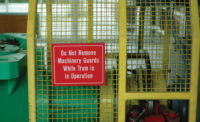OSHA’s standard on ladder safety — 1926.1053 — was among the top 10 most-cited violations in fiscal year 2014, with 2,911 citations and 2,267 inspections within that timeframe in all industries. The total cost of those violations was $4,212,627. The highest number of citations (2,825) occurred in the construction industry.
Top five ladder violations
The top five ladder violations cited were:
™ Requirements for portable ladders used for accessing upper landing surfaces—1926.1053(b)(1)
™ Ladder use only for its designated purpose—1926.1053(b)(4)
™ Not using the top or top step of stepladder as a step—1926.1053(b)(13)
™ Marking portable ladders with structural defects with tags noting them as defective—1926.1053 (b)(16)
™ Ladders Shall be Used only on Stable and Level Surfaces unless Secured–1926.1053(b)(6)
Basic rules
Basic safety rules that apply to most tools also apply to ladder use. The American Ladder Institute offers several tips to avoid ladder safety violations.
Stay off the ladder if you feel tired or are prone to losing your balance. Do not use ladders outdoors in high wind or storms. Wear slip-resistant shoes. Before using a ladder, inspect it to make sure it is in working condition; ladders with loose or missing parts and ladders that sway or lean to the side should not be used.
The Institute also says the Duty Rating of the ladder must be greater than the total weight of the climber and tools placed on the ladder. The length of the ladder must be sufficient so that the climber doesn’t have to stand on the top rung.
Only one person at a time is permitted on a ladder unless it’s specifically designed for more than one climber. Ladders must not be placed in front of closed doors that can open toward the ladder.
Always read the safety information labels on the ladder. The climber is not considered qualified or adequately trained to use the ladder until familiar with this information.
Risk factors
Factors contributing to falls from ladders include haste, sudden movement, lack of attention, the condition of the ladder, the user’s age or physical condition, and the user’s footwear. Improper climbing posture could create user clumsiness and also may cause falls.
According the Institute, climbers can reduce chances of falling during the climb by:
™ wearing slip-resistant shoes with heavy soles to prevent foot fatigue;
™ cleaning the soles of shoes to maximize traction;
™ using towlines, a tool belt or an assistant to convey materials so the climber’s hands are free;
™ climbing slowly and deliberately while avoiding sudden movements;
™ never attempting to move a ladder while standing on it.
The American Ladder Institute suggests a technique called the Three Points-of-Contact Climb to ensure proper ladder use. At all times during ascent, descent and working, the climber must face the ladder and have two hands and one foot, or two feet and one hand in contact with the ladder steps, rungs and/or side rails.





